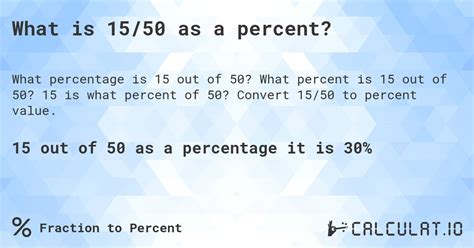15 Out Of 50 As A Percentage
Kalali
Mar 28, 2025 · 4 min read

Table of Contents
15 out of 50 as a Percentage: A Comprehensive Guide
Calculating percentages is a fundamental skill in various aspects of life, from academic pursuits to professional settings. Understanding how to convert fractions into percentages is crucial for interpreting data, making comparisons, and understanding proportions. This comprehensive guide will delve into the calculation of 15 out of 50 as a percentage, explaining the process in detail and providing various applications of this knowledge. We’ll also explore related percentage calculations and offer practical examples to solidify your understanding.
Understanding Percentages
A percentage is a way of expressing a number as a fraction of 100. The word "percent" literally means "per hundred." Therefore, 15% means 15 out of 100, or 15/100. Understanding this fundamental concept is key to converting fractions into percentages.
Calculating 15 out of 50 as a Percentage
To calculate 15 out of 50 as a percentage, we need to follow these simple steps:
Step 1: Express the Fraction
First, represent the given information as a fraction. In this case, it's 15 out of 50, which can be written as 15/50.
Step 2: Convert the Fraction to a Decimal
To convert the fraction 15/50 into a decimal, divide the numerator (15) by the denominator (50):
15 ÷ 50 = 0.3
Step 3: Convert the Decimal to a Percentage
To convert the decimal 0.3 into a percentage, multiply it by 100 and add the percentage sign (%):
0.3 × 100 = 30%
Therefore, 15 out of 50 is equal to 30%.
Alternative Methods for Calculating Percentages
While the above method is straightforward, there are other ways to calculate percentages, particularly helpful when dealing with more complex fractions.
Method 1: Using Proportions
You can use proportions to solve for the percentage. Set up a proportion where x represents the percentage:
15/50 = x/100
Cross-multiply:
50x = 1500
Solve for x:
x = 1500/50 = 30
Therefore, x = 30%, confirming our previous result.
Method 2: Simplifying the Fraction First
Sometimes, simplifying the fraction before converting to a decimal can make the calculation easier. The fraction 15/50 can be simplified by dividing both the numerator and the denominator by their greatest common divisor (GCD), which is 5:
15 ÷ 5 = 3 50 ÷ 5 = 10
This simplifies the fraction to 3/10. Now, converting 3/10 to a decimal is simpler:
3 ÷ 10 = 0.3
Then, convert the decimal to a percentage:
0.3 × 100 = 30%
Practical Applications of Percentage Calculations
Understanding percentage calculations is essential in various real-world scenarios. Here are a few examples:
1. Academic Performance
Imagine a student scored 15 out of 50 marks on a test. Knowing that this is equivalent to 30%, allows for easy comparison with other scores and a clear understanding of the student's performance.
2. Sales and Discounts
Stores often advertise discounts as percentages. If a store offers a 30% discount on an item, and you need to calculate the discount amount, you can use your understanding of percentages. For instance, if an item costs $100, a 30% discount would be $30 (30% of $100).
3. Financial Calculations
Percentages are crucial in finance. Calculating interest rates, returns on investments, and tax rates all rely heavily on percentage calculations.
4. Data Analysis and Statistics
In data analysis and statistics, percentages are frequently used to represent proportions and trends within datasets. For example, if a survey reveals that 15 out of 50 people prefer a particular product, this can be expressed as 30%, offering a clear insight into consumer preferences.
Related Percentage Calculations
Understanding how to calculate 15 out of 50 as a percentage also helps in understanding related calculations:
Calculating 35 out of 50 as a Percentage
Following the same steps:
35/50 = 0.7
0.7 × 100 = 70%
Calculating a Percentage of a Number
If you need to calculate 30% of a number, say 200, you would multiply the number by the decimal equivalent of the percentage:
200 × 0.30 = 60
Finding the Original Number from a Percentage
If you know a percentage and the resulting value, you can find the original number. For example, if 30% of a number is 60, you can find the original number by dividing the value by the decimal equivalent of the percentage:
60 ÷ 0.30 = 200
Conclusion
Calculating percentages is a fundamental skill with numerous real-world applications. Understanding how to convert fractions to percentages, as demonstrated with the example of 15 out of 50, is crucial for accurate calculations and data interpretation across various fields, from academics to finance and beyond. Mastering this skill will enhance your problem-solving abilities and allow you to confidently navigate various quantitative scenarios. Remember to practice regularly to solidify your understanding and build fluency in percentage calculations. By understanding the core principles and exploring different calculation methods, you can confidently tackle a wide range of percentage-related problems.
Latest Posts
Latest Posts
-
Cuanto Es 72 Pulgadas En Centimetros
Mar 31, 2025
-
How Many Meters Is 29 Feet
Mar 31, 2025
-
How Much Is 12 Fluid Oz
Mar 31, 2025
-
How Much Is 64 Oz In Cups
Mar 31, 2025
-
What Is The Second Step In Dna Replication
Mar 31, 2025
Related Post
Thank you for visiting our website which covers about 15 Out Of 50 As A Percentage . We hope the information provided has been useful to you. Feel free to contact us if you have any questions or need further assistance. See you next time and don't miss to bookmark.
